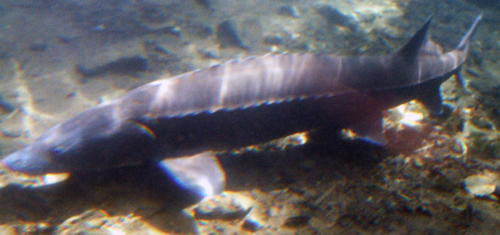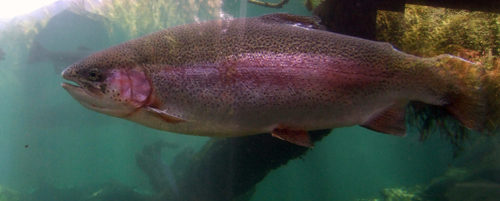
-Twentieth in a Series-
By Donald H. Harrison

 CASCADE LOCKS, Oregon – Herman the Sturgeon is by far the biggest attraction at the Bonneville Fish Hatchery here. Approximately 70 years old, Herman is 10 feet long and weighs 450 pounds. He is midsize for his species, with some sturgeons having been known to grow to 20 feet and to weigh as much as 1,000 pounds.
CASCADE LOCKS, Oregon – Herman the Sturgeon is by far the biggest attraction at the Bonneville Fish Hatchery here. Approximately 70 years old, Herman is 10 feet long and weighs 450 pounds. He is midsize for his species, with some sturgeons having been known to grow to 20 feet and to weigh as much as 1,000 pounds.
With steelheads and some other, smaller white sturgeon for company, Herman glides around a pond and occasionally turns on his side to give a nice full-lipped smile to the human visitors watching him through the glass window of the viewing center. Unlike most fish, a sturgeon’s mouth is not positioned at the front of his head, but instead is located below the front part of his long body, making it easier for him to feed off the pond’s bottom.
Herman, caught in the Columbia River in 1998, is a permanent visitor at the hatchery operated here by Oregon Fish and Wildlife. The real business of the hatchery each year is to raise 8 million Chinook salmon; 1.2 million Coho salmon; 200,000 summer steelhead and 60,000 winter steelhead, all of which are released to the Columbia River to swim downstream to the Pacific Ocean. Most of these young fish don’t make it – they are eaten along the way by bigger fish, birds, and mammals—but those that do may spend several years in the Pacific Ocean before swimming back upstream to spawn and, in the case of the salmon, to die.
This continuing cycle-of-life process has no immediate effect on Herman, who is expected to live for at least another 30 years and is kept in the pond purely for the enjoyment of hatchery visitors. Visitors can buy fish food from dispensers for the steelheads, which also are known as “rainbow trout,” but they cannot purchase food for Herman who prefers “to eat live things that have died,” according to hatchery officials.

If sturgeons knew as much about human eating habits as we do about theirs, I believe Herman might reserve his widest smile for any Orthodox Jews who might come to visit. In that they follow strict halacha (Jewish law), Orthodox Jews won’t eat Herman or any of his sturgeon friends, whereas Jews of other movements might. Reform Jews no longer follow halacha, and Conservative Jews are split on whether or not sturgeon can be considered kosher.
To be kosher, according to Leviticus 11: 9-12, fish must have both fins and scales. Herman has fins, to be sure, but whether he has scales is a matter of controversy. The sturgeon, similar to the swordfish, starts life with scales, but loses them later in life, so that their skin resembles that of a shark, which is very smooth and very unkosher.
Conservative Jews say that since Herman started with scales, he’s passed the test, and he’s kosher. Orthodox Jews, on the other hand, say without scales, sturgeon are forbidden. One could argue that even sharks have scales, but they are soft ones. No matter, ruled the great Jewish 12th century Jewish philosopher, doctor, and religious authority Maimonides, unless the scales can be easily plucked off the fish by hand or with a knife, but without tearing the skin, the fish is not kosher. In Leviticus such fish are described as an abomination.
From Herman’s point of view, one supposes, it is better to be an abomination than the entrée for someone’s dinner. Only “Charlie,” the constantly passed-over tuna, in the animated Starkist Tuna commercials wants to be someone’s fish dinner (although he has his imitators in the tough, hard-to-eat chickens who are forever being rejected in Foster Farm commercials.)

As Herman just lolls in his pond, seemingly content, the Chinook salmon have much more to worry about at the hatchery. At the end of their life cycles, instinct drives them to return from the ocean up the Columbia River to their spawning grounds, where, if the process weren’t interrupted, the females would burrow into the river bottom, lay their eggs where males could come along and fertilize them, and then die.
Instead the salmon are diverted up ladders to the hatchery where the females are anaesthetized before their eggs are removed from their sacks and put into buckets. Sperm from the males then is poured over the eggs in a rudimentary but effective fertilization process. The eggs are then incubated, and the fingerlings are allowed to grow to a sufficient size before being released via a nearby stream to the Columbia River.
Unlike sturgeon, the salmon have more to fear from Jews, whether the Jews be Orthodox, Conservative, Reform, or adherents to any other movement.
Of course, I’m talking about our people’s love of lox, which is made from the bellies of the salmon.
Can you imagine, if salmon were sentient beings, how agitated they would become if a human looking over the tanks where they are kept, was espied to be carrying a half bagel in each hand?
*
Harrison is editor of San Diego Jewish World. He may be contacted via donald.harrison@sdjewishworld.com